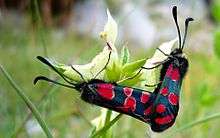Zygaena carniolica
| Zygaena carniolica | |
|---|---|
.jpg) | |
| in Bulgaria | |
| Scientific classification | |
| Kingdom: | Animalia |
| Phylum: | Arthropoda |
| Class: | Insecta |
| Order: | Lepidoptera |
| Family: | Zygaenidae |
| Genus: | Zygaena |
| Species: | Z. carniolica |
| Binomial name | |
| Zygaena carniolica (Scopoli, 1763) | |
| Synonyms | |
|
List
| |
Zygaena carniolica, sometimes described as the crepuscular burnet or eastern burnet, is a member of the family Zygaenidae.
Subspecies
Subspecies include:[1][2]
- Zygaena carniolica carniolica
- Zygaena carniolica albarracina Staudinger, 1887
- Zygaena carniolica amanda Reiss, 1921
- Zygaena carniolica amistosa Aistleitner & Lencina Gutierrez, 1995
- Zygaena carniolica apennina Turati, 1884
- Zygaena carniolica berolinensis Lederer, 1853
- Zygaena carniolica cruenta (Pallas, 1773)
- Zygaena carniolica demavendi Holik, 1936
- Zygaena carniolica descimonti Lucas, 1959
- Zygaena carniolica diniensis Herrich-Schaffer, 1852
- Zygaena carniolica flaveola (Esper, 1786)
- Zygaena carniolica graeca Staudinger, 1870
- Zygaena carniolica hedysari (Hübner, 1796)
- Zygaena carniolica leonhardi Reiss, 1921
- Zygaena carniolica magdalenae Abeille, 1909
- Zygaena carniolica modesta Burgeff, 1914 (France, Belgium, Luxembourg, Germany. Austria, the Czech Republic and Poland)
- Zygaena carniolica moraulti Holik, 1938
- Zygaena carniolica piatkowskii de Freina, 2006
- Zygaena carniolica rhaeticola Burgeff, 1926
- Zygaena carniolica roccii Verity, 1920
- Zygaena carniolica siciliana Reiss, 1921
- Zygaena carniolica virginea (Muller, 1766)
- Zygaena carniolica wiedemannii Menetries, 1839
Distribution
This species can be found in most of Europe, except Britain Isles and northern Scandinavia.[1][2] It is also present from Western Asia to Iran.[3]
Habitat
It inhabits warm and dry areas, grasslands and limestone substrate, steppe slopes and dry pastures.
Description
The wingspan is 30–35 mm. Forewings are bluish-black with six red spots surrounded by yellow. Hindwings have a red color with a black border. The outer spots are often in the shape of a crescent. The abdomen is black-blue, sometimes with a red belt.[4] The caterpillar is light green with a series of triangular black spots on the sides of the body. Pupae are black-brown, with a white or yellowish ovoid cocoon.[5]
This species is rather similar to Zygaena algira, Zygaena maroccana, Zygaena occitanica, Zygaena orana and Zygaena youngi.
Biology
It is an univoltine species. Adults are on wing from July to August. Adults feed on the nectar of flowers in the Fabaceae family.The larvae feed on Lotus, Anthyllis, Dorycnium and Onobrychis species.[6] They frequently rest large numbers on flowers. Pupation occurs in May–June. The caterpillars hibernate.
Gallery
 Mating pair
Mating pair Adult
Adult_carniolica-M-Abruzzo%2C_Chieti_Umgebung%2C_Casalincontrada-E-MK-21389a.jpg) Mounted specimen
Mounted specimen Illustration
Illustration Resting
Resting
Bibliography
- Abivardi, Cyrus (2008). "Burnet moth biology". V Capinera, John L. Encyclopedia of entomology (2. izd.). Heidelberg: Springer Science+Business Media. str. 617–622. ISBN 978-1-4020-6242-1.
- Binzenhöfer, Birgit; Schröder, Boris; Strauss, Barbara; Biedermann, Robert; Settele, Josef (2005). "Habitat models and habitat connectivity analysis for butterflies and burnet moths – The example of Zygaena carniolica and Coenonympha arcania". Biological Conservation 126: 247–259.
- C. M. Naumann, G. M. Tarmann, W. G. Tremewan: The Western Palaearctic Zygaenidae. Apollo Books, Stenstrup, 1999, ISBN 87-88757-15-3
- O. Karsholt, J. Razowski (eds.), 1996. The Lepidoptera of Europe: a distributional checklist
References
- 1 2 Fauna Europaea
- 1 2 Funet - Markku Savela's Lepidoptera and some other life forms
- ↑ Nature Wonders
- ↑ Chinery, Michael (1989). Collins new generation guide to the butterflies and day-flying moths of Britain and Europe. Collins. str. 157. ISBN 9780002197854
- ↑ Lepiforum.de
- ↑ Paolo Mazzei, Daniel Morel, Raniero Panfili Lepiforum.de Moths and Butterflies of Europe and North Africa
| Wikimedia Commons has media related to Zygaena carniolica. |
| Wikispecies has information related to Zygaena carniolica |